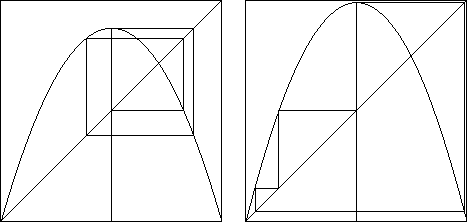Deterministic Chaos
Logistic Map Cycles
As s increases from 0 to 4, we observe
* Each stable cycle goes through an infinite sequence of period-doublings.
For example, the stable fixed point gives rise to a stable 2-cycle just as it becomes
unstable.
This stable 2-cycle gives rise to a stable 4-cycle just as it becomes unstable.
This stable 4-cycle gives rise to a stable 8-cycle just as it becomes unstable.
In general, any stable n-cycle gives rise to a family
2n-cycle ->
4n-cycle -> 8n-cycle -> 16n-cycle -> ...
* Each tangent bifurcation produces a stable cycle, that then gives rise to a
cascade of period-doubling bifurcations.
* For each s-value, there is at most one stable cycle, and for many there are none.
* If there is a stable cycle, the iterates of 1/2 converge to the cycle. This was
proved by Fatou and Julia. (What's special about x = 1/2 is that it is the
critical point, the point at which the logistic map's derivative is 0.)
* Call the range of s-values of a stable cycle and all its stable
period-doubling descendants a periodic window.
The order in which these periodic windows arise is a bit complicated, but
completely understood.
They showed every periodic window
contains an s-value for which x = 1/2 belongs to the cycle. These
cycles are called superstable.
With each superstable
cycle, Metropolis, Stein, and Stein associated a sequence of symbols L and R, denoting
whether a point of the cycle falls to the Left or Right of 1/2.
The two 4-cycles
shown below have sequences RLR and RLL. (Four-cycles containing
x = 1/2 have only three symbols, because the cycle is always understood to
start with x = 1/2.)
The heart of the proof is finding how the symbol sequences
of any two superstable cycles are related to the order of the s-values at which they occur.
* For some s-values there is no stable cycle at all, and the dynamics are chaotic.
Jakobsen proved the chaotic s-values are a non-negligible portion of the range
3.6 <= s <= 4, but the amount of chaos is difficult to estimate.
Return to Logistic Map Cycles.

